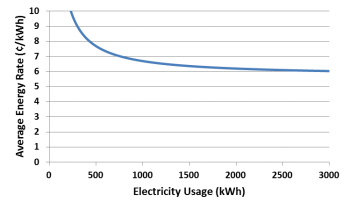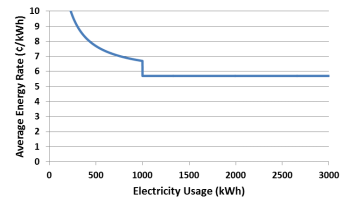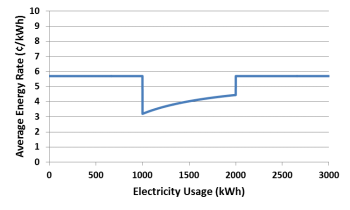Practical guide to Texas electricity plans. Shopping for a low electricity rate for your Texas home can be confusing. There are a dizzying number of electricity providers from which to choose. Each provider, in turn, may have multiple offers including prepaid electricity, variable rate plans, and fixed rate plans. Fixed price electricity plans are the most common and the most popular with consumers. The benefit of a fixed price plan is that your rate remains constant for the term of the agreement. This gives you peace of mind by protecting you from market price changes. However, what are you really locking in?
Most Texas electricity providers pass along the transmission and distribution costs, taxes, and regulatory fees. You are only locking in the energy portion of your bill. In most cases, the energy component is not a single rate but a rate structure. The Electricity Facts Label (EFL) describes the rate structure and shows the average price at the 500, 1000, and 2000 kWh consumption levels. This is designed to allow you to make apples-to-apples comparisons between electricity offers. However, you will find that electricity providers use varying rate structures. To help you select the best electricity plan for your home, here is a brief overview of the four most common types of fixed price rate structures.
Base Charge
 This is one of the most straightforward approaches to residential electricity offers. The electricity provider assesses a base charge (e.g., $9.95) every month. All electricity consumed bills at a single fixed rate. The base charge covers the electricity provider’s fixed costs such as billing and customer service. The usage rate recovers the variable cost of the serving the customer including the energy itself. As shown in the graph, the impact of the base charge on the average price diminishes at high usage levels. In other words, if you use very little electricity, the base charge is a bigger part of your monthly bill.
This is one of the most straightforward approaches to residential electricity offers. The electricity provider assesses a base charge (e.g., $9.95) every month. All electricity consumed bills at a single fixed rate. The base charge covers the electricity provider’s fixed costs such as billing and customer service. The usage rate recovers the variable cost of the serving the customer including the energy itself. As shown in the graph, the impact of the base charge on the average price diminishes at high usage levels. In other words, if you use very little electricity, the base charge is a bigger part of your monthly bill.
Low Usage Base Charge
 This rate structure is similar to the one described above except that the base charge is waived if your monthly usage exceeds a certain amount. Electricity providers using this structure are essentially combining two different approaches to recovering their fixed costs. For low volume customers, they are using a base charge to cover billing and other fixed costs. For higher-volume customers, those costs are baked into the rate. The EFL will list the cut-off usage level for assessing the base charge. Consequently, if your monthly usage consistently exceeds this level, this is probably a good rate structure for your home.
This rate structure is similar to the one described above except that the base charge is waived if your monthly usage exceeds a certain amount. Electricity providers using this structure are essentially combining two different approaches to recovering their fixed costs. For low volume customers, they are using a base charge to cover billing and other fixed costs. For higher-volume customers, those costs are baked into the rate. The EFL will list the cut-off usage level for assessing the base charge. Consequently, if your monthly usage consistently exceeds this level, this is probably a good rate structure for your home.
Usage Bandwidth Bill Credit
 With this rate structure, a financial incentive (credit) is applied to your bill if your usage falls within a specified range. For example, you will receive a $50 bill credit if you usage falls between 1000 and 2000 kWh. Outside of that range, the bill credit vanishes. As shown in the graph, the bill credit has the greatest impact on average price at the lower end of the range. The benefit gradually declines as you approach the top of the range before disappearing altogether. While there is nothing sinister about this approach, it has been abused by electricity providers on the Texas electricity shopping website. Before signing up for this type of offer, be sure that your monthly usage falls within the incentive range more times than not.
With this rate structure, a financial incentive (credit) is applied to your bill if your usage falls within a specified range. For example, you will receive a $50 bill credit if you usage falls between 1000 and 2000 kWh. Outside of that range, the bill credit vanishes. As shown in the graph, the bill credit has the greatest impact on average price at the lower end of the range. The benefit gradually declines as you approach the top of the range before disappearing altogether. While there is nothing sinister about this approach, it has been abused by electricity providers on the Texas electricity shopping website. Before signing up for this type of offer, be sure that your monthly usage falls within the incentive range more times than not.
Usage Bill Credit
 This structure is similar to the usage bandwidth incentive described above. The primary difference is that the incentive triggers at specified usage level and then remains. Per the graph, the impact of incentive on average price declines as usage increases. However, it never goes away completely. This approach is similar in some ways to the low usage base charge. In this case, rather than assessing a base charge at low usage levels, the bill credit is not applied. This is a good rate structure so long as you typically use enough electricity to qualify for the bill credit.
This structure is similar to the usage bandwidth incentive described above. The primary difference is that the incentive triggers at specified usage level and then remains. Per the graph, the impact of incentive on average price declines as usage increases. However, it never goes away completely. This approach is similar in some ways to the low usage base charge. In this case, rather than assessing a base charge at low usage levels, the bill credit is not applied. This is a good rate structure so long as you typically use enough electricity to qualify for the bill credit.
Best Electricity Offer
The best electricity offer is the one that results in the lowest bill at your home. If a single rate structure was right for every consumer, electricity providers would quickly converge to that structure. The truth of the matter is that our needs are unique and there is justification for taking different approaches to fixed price electricity offers. The most important thing to have available when evaluating plans is your monthly electricity usage. You can collect this information from your past billing statements or, in many cases, access it through your current provider’s online customer portal. You can also view your usage data online at the Texas smart meter website. Having this information handy will help you find the best electricity plan for your home.


